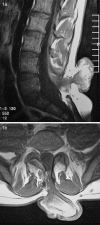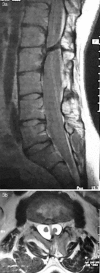Tethered cord syndrome in adulthood
- PMID: 18795476
- PMCID: PMC2565560
- DOI: 10.1080/10790268.2008.11760722
Tethered cord syndrome in adulthood
Abstract
Objective/background: The standard treatment for tethered cord syndrome (operative vs nonoperative management) that presents in adulthood remains controversial. A comparative study of tethered cord syndrome in adulthood is needed.
Design: A retrospective chart-based analysis.
Methods: Patients admitted to Gulhane Military Medical Academy Department of Neurosurgery for management of caudal spinal cord tethering from June 1999 through December 2006 (N = 22).
Results: Conus level was normal in 1 patient with split cord malformation and dermal sinus. Tight terminal filum was found in 21 patients, including postrepair myelomeningocele tethered cord in 4, lipomyelomeningocele/meningocele in 8, split cord malformation in 3, dermal sinus in 7, and syringomyelia in 3. The most common complaints were back pain (15 patients, 68.1%), bladder dysfunction (8, 36.3%), fecal incontinence (2, 9.09%), and leg pain (7, 31.8%). One patient had hydrocephalus (4.5%). Ten of 22 patients underwent surgery; 8 of 10 patients had detethering; and 12 patients refused surgery. Postoperative cerebrospinal fluid leakage requiring reinforcement sutures occurred in 1 patient. There were no infectious complications. Neurologic status and outcomes were compared with preoperative findings.
Conclusions: Some patients refuse surgery despite severe neurologic disturbances. Neurosurgeons should fully explain the risks and benefits of surgery for tethered cord to the patient and family. A much larger and prospective randomized series is needed to determine the effects of operative vs nonoperative management of tethered cord syndrome in adulthood.
Figures



References
-
- Yamada S, Won DS. What is the true tethered cord syndrome. Childs Nerv Syst. 2007;23:371–375. - PubMed
-
- Garceau GJ. The filum terminale syndrome (the cord-traction syndrome) J Bone Joint Surg Am. 1953;35:711–716. - PubMed
-
- Hoffman HJ, Hendrick EB, Humphreys RP. The tethered spinal cord: its protean manifestations, diagnosis and surgical correction. Childs Brain. 1976;2:145–155. - PubMed
-
- Yamada S, Zinke DE, Sanders D. Pathophysiology of “tethered cord syndrome.”. J Neurosurg. 1981;54:494–503. - PubMed
-
- Rajpal S, Tubbs RS, George T, et al. Tethered cord due to spina bifida occulta presenting in adulthood: a tricenter review of 61 patients. J Neurosurg Spine. 2007;6:210–215. - PubMed
Publication types
MeSH terms
LinkOut - more resources
Full Text Sources
Medical
